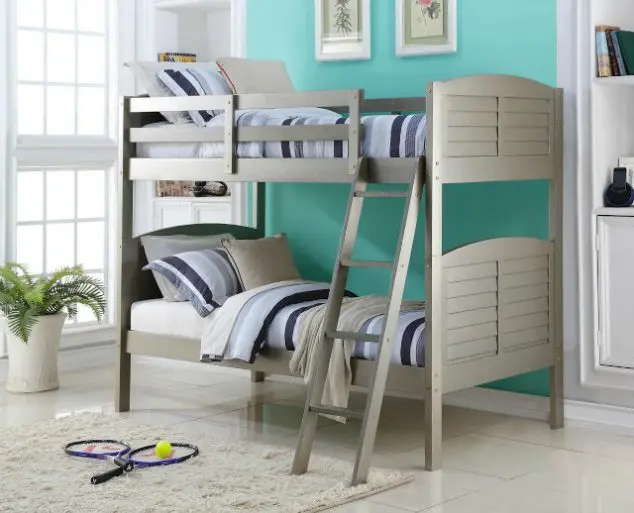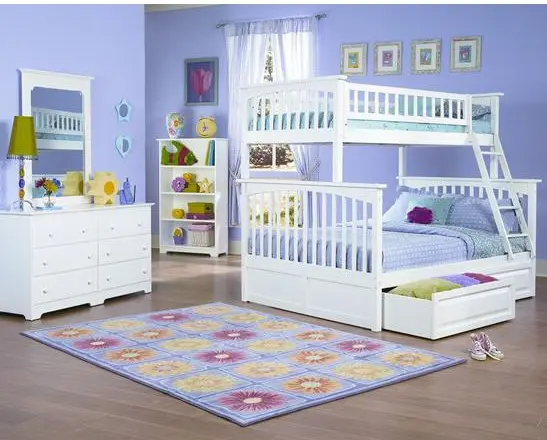My kids share a small bedroom so we wanted a bunk bed for them. There are many types of bunk beds for kids and different bunk beds work better for different shapes of rooms and for different needs. Bunk beds have gained in popularity because of their space-saving and multi-purpose benefits. Here are five types of bunk beds to consider with affiliate links so you can explore further.
What are bunk beds and where did they come from?
Bunk beds are made up of two beds, one on top of the other. A frame supports these two beds, along with a ladder going to the top bed. There is really no evidence on how the use of bunk beds began or where it started. However, during the ancient times, the Egyptians who introduced the use of beds, were found to have utilized a loft bed, which is similar to that of a bunk bed and in fact some consider it as a type of bunk bed.
Bunk beds are ideal for rooms with limited floor space, such as small rooms, dorms, military camps, and even ships. They are also fun for your kids who are sharing the same room. Bunk beds are usually made up of wood or metal.
What age is a child ready for a bunk bed?
Children are generally ready for a bunk bed around age 6. At this age, they typically have developed the coordination and understanding needed to safely climb up and down the ladder and follow safety rules. It’s important to ensure the child sleeping on the top bunk is capable of doing so safely. For younger children, it’s safer for them to sleep on the bottom bunk or a regular bed.
Types of Bunk Beds For Small Spaces:
1. Twin over twin bunk beds.
This is simply described as a twin-sized bunk bed on top of another twin bunk bed. Otherwise known as standard bunk bed, this is the most common type of bunk bed available in the market and sought after by users because it saves a lot of space.
However, even among twin over twin bunk beds for kids, there is a lot of variety- some even have tents or slides! There are metal bunk beds and wooden bunk beds. Sometimes, they even slip a trundle bed under the bottom bunk to make it into a triple bunk bed. These single beds are great for younger children and adults alike. To see 16 twin over twin types click here
Photo Credit: BunkBedSnow.com
2. Twin over full bunk beds.
This type of bunk bed is a twin-sized bed on top of a full-sized bed. You can also choose other bed size combination, such as full over full bunk beds, depending on your needs and the size of bed your room can accommodate. Again these twin over full bunk bed options can vary significantly from a plain version to a Cool Bunk Beds with Twin/Full Club House Design which you can see if you click here. These bunk bed frames do take up more floor space but they provide more sleeping space too.
3. L-shaped bunk beds.
This type of bunk bed is designed in a such a way that the separate beds form an L when viewed from the top. The bottom bed is positioned forming a right angle with the upper bunk. The other side is usually utilized as a working or study table great for you and your kids. Alternatively, the extra space can houses a set of storage drawers.
4. Futon bunk beds.
Futon bunk beds are very practical for small rooms and apartments, where you can integrate a couch and bed with one piece of furniture. This type of bunk beds for kids are designed with a twin or full top bed and a bottom bed, usually full-sized, that can be converted into a couch for day use. A futon bunk bed is a good option for a guest room or a small apartment.
5. Loft Bunk Beds
This kind of bunk bed offers an area down below which can be used for storage or desk work space or a reading nook or anything your child pleases! Loft bunk beds for kids are a great way to make a small room bigger. To see over 10 different types of bunk beds with loft beds for kids, click here.
Are bunk beds safe?
Bunk beds can be safe if proper precautions are taken, but there are risks associated with them, especially for younger children. Here are some safety tips to consider:
Safety Guidelines for Bunk Beds:
- Age Recommendation: The top bunk is generally recommended for children aged 6 and older. Younger children are at a higher risk of falling.
- Guardrails: Ensure the top bunk has guardrails on both sides. The guardrails should be at least 5 inches above the mattress to prevent falls, and there should be no gaps larger than 3.5 inches that could trap a child’s head.
- Sturdy Ladder: The ladder should be securely attached to the bed and easy to climb. Teach children to always use the ladder instead of jumping off the bed.
- Mattress Size: Use the correct size mattress for both the top and bottom bunks. An ill-fitting mattress can create gaps where a child could get stuck.
- No Rough Play: Discourage roughhousing on or around the bunk bed to prevent falls or injuries.
- Ceiling Clearance: Ensure there’s enough space between the top bunk and the ceiling to prevent the child from bumping their head. Also make sure it not located where they could be too close to a ceiling fan. A kid in one of my classes had to get stiches when I was little
- Nighttime Lighting: Consider installing a nightlight near the bunk bed to help children see the ladder at night.
- Regular Checks: Periodically check the bed for any loose screws, bolts, or parts that may need tightening or replacement.
By following these guidelines and ensuring that the bunk bed is well-constructed and properly assembled, you can minimize the risks and provide a safe sleeping environment for your child.
Types Of Bunk Bed Conclusion
It is great to see how bunk beds have evolved from standard bunk beds to sophisticated futon beds and fun loft beds, allowing you to choose from many different styles that suit your needs. Contemporary bunk beds often offer lots of extra features such as storage or play area. Bunk beds not only help you with your limited room space, but they also satisfy your style and help create a fun room for your kids to sleep, play, and study. Check out this one!
I found my twin over twin bunk bed on craigslist.com. It was a fabulous deal for solid wood bunk beds but it did take a lot of work. My husband sanded the bunk bed down to get out all the scratches, dents, and marker spots. Then I painted it with a coat of primer and a coat of white. My kids got out the stickers and decorated too! Here is a photo of how their bunk beds turned out.
Later, when my daughter moved to her own room, we bought a loft bunk bed with a built-in ladder for her new room. These types of small space bunk beds are perfect for creating a study area below the top bunk.
Bunk beds offer several advantages, especially for families with limited space. They maximize vertical space, allowing two beds to fit in the footprint of one, which is ideal for small bedrooms. Bunk beds also create a fun, adventurous sleeping experience for kids, often making bedtime more exciting. Additionally, they provide extra floor space for play or other furniture, and some models come with built-in storage or desks, further enhancing their functionality. What are your favorite types of bunk beds for kids?
Related Posts:
Fabulous Kids Rooms For Design Inspiration




Deepthi Petal says
Nice Post. I like the space saving and functional bunk beds with stairs for kids. It is a great option to help provide plenty of space.